Botanical name:
Eschscholzia californica
Cham.
Habitat and growth pattern:
California Poppy can grow up to two feet tall, but is often much shorter depending on the soil and availability of water. The grey-green leaves are finely divided, giving it an airy quality, often tinged at the tips with a bit of fire red.
The flower bud is enclosed in a cap-like, pointed green calyx, made of two fused sepals, unlike most flowers, which are held in the embrace of the calyx from below. As the flower begins to open the calyx cap lifts off and falls away, revealing a furled flower sitting on a circular pink platform-like receptacle, which remains during the flowering and seed stage of the plant.
At the end of their flowering cycle, the petals fall away and reveal an elongated seed pod (in contrast to the more globular seedpod of the opium poppy). The seed pod ripens from green to brown, and then “pops” open to release the small black seeds, similar in appearance to the poppy seeds used in foods.
Name, History and Uses:
Long before the Europeans came to the New World, the Native American peoples used various preparations of the California Poppy plant for toothaches, to relieve headaches and stomach aches, and as a sleep aid for children. California Poppy tincture is currently used as mild sedative and analgesic, and also as an anxiolytic (anti-anxiety remedy). Unlike its distant cousin Papaver somniferum, the opium poppy, California Poppy contains no opiates, and is non-addictive and safe. It derives its sedative qualities from other alkaloids, and is useful in dealing with many forms of pain and anxiety, including difficulty sleeping. The tincture is very bitter, a taste little appreciated in the Standard American Diet (SAD), but quite stimulating to the digestive and immune systems. Understanding the healing gesture of essence: The California Poppy is truly a plant of the sun, opening and closing in response to the radiance of the light and flourishing in open, sunny meadows. The feather-like airy foliage, fiery colors that penetrate even into the leaves and strong seeding process are also indicative of its strong air and fire identity. The archetypal form and gesture of this flower involves the polarity of inner containment and outer movement. The expressive, mobile elements of fire and air which so prominently characterize the California Poppy, are also anchored in its luminous golden chalice.
The human soul is also challenged by the mesmerizing quality of light, propelling one outside the boundaries of body and soul for what we feel we lack within. It is fitting that California Poppy is the California state flower, for certainly the modern California experience reflects many aspects of this state of soul consciousness: the California Gold Rush, the glitter and glamour of Hollywood, charismatic cults, and various drugs that promise transcendent ecstasy, enlightenment, or freedom from pain and restriction. The California Poppy helps the soul to gather its forces of light and warmth so that they can radiate within the chalice of the heart as an enduring presence. This light of the heart is a form of spiritual Gold, which finds its counterpart in Nature in the metal of gold deep within the earth, and the sun itself which pulses as life-giving solar heart for the whole of the earth.
Key patterns of imbalance/indications: Escapism, ungrounded spirituality, infatuation with glamour, addiction, intolerable pain, anxiety, difficulty sleeping Positive qualities: ability to be with oneself despite pain, discomfort or anxiety; knowing the source of light and warmth within oneself; containment of bodily and soul forces creating greater calm and resiliency; radiant heart-centered spirituality Photography by Richard Katz View a time lapse video of the California Poppy opening to the light: |
||||||
|
|

To install this Web App in your iPhone/iPad press ![]() and then Add to Home Screen.
and then Add to Home Screen.
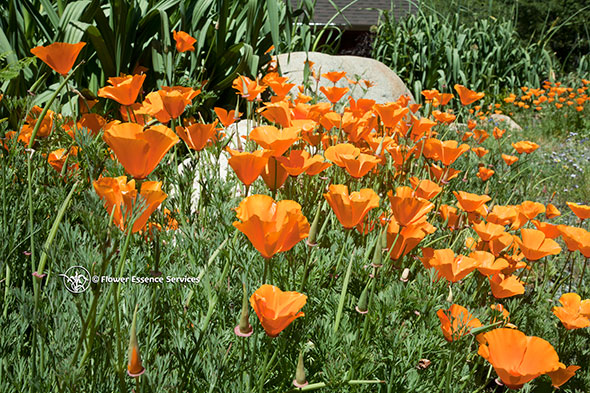
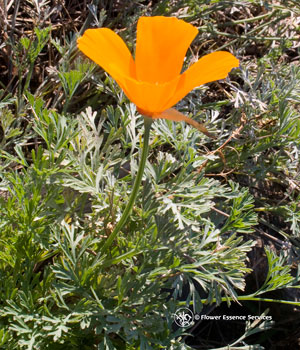 California Poppy is a native California wildflower (and the official state flower), which also grows throughout the west coast of North America, and has been widely naturalized in many parts of the world. It favors open sunny, habitats with sandy, well-drained soils, and is summer-drought tolerant. However, it is adaptable, and can also flourish as a garden plant, and in moist environments. It is found along the Pacific coastal bluffs and hills, in the inland valleys, foothills and lower mountain elevations, but not in the high alpine meadows. California Poppy is a short-lived perennial with a long tap-root. However in colder climates, it grows as an annual. In either case, it easily re-seeds itself, and will flourish where there is a minimum of competition from other plants.
California Poppy is a native California wildflower (and the official state flower), which also grows throughout the west coast of North America, and has been widely naturalized in many parts of the world. It favors open sunny, habitats with sandy, well-drained soils, and is summer-drought tolerant. However, it is adaptable, and can also flourish as a garden plant, and in moist environments. It is found along the Pacific coastal bluffs and hills, in the inland valleys, foothills and lower mountain elevations, but not in the high alpine meadows. California Poppy is a short-lived perennial with a long tap-root. However in colder climates, it grows as an annual. In either case, it easily re-seeds itself, and will flourish where there is a minimum of competition from other plants.
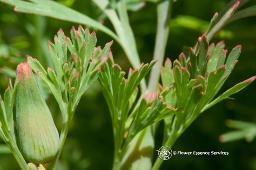





 Initially, the four-petaled flower, typically golden colored, although sometimes yellow, has the shape of the calyx, larger at the base, and tightly wound into a point on top. As it unfurls, it becomes more cylindrical, and then unfurls the petals to become a chalice-like cup, 2 to 4 inches in diameter. The four luminescent, silky petals slightly overlap to enclose an inner space of golden light, within which are found the stamens and pistil. The flowers reveal their close connection to the sunlight, opening mid-morning, then closing again in the evening, with the fading of the light. Even during mid-day, if it becomes cloudy the blossom will close, and then re-open when the sunlight returns.
Initially, the four-petaled flower, typically golden colored, although sometimes yellow, has the shape of the calyx, larger at the base, and tightly wound into a point on top. As it unfurls, it becomes more cylindrical, and then unfurls the petals to become a chalice-like cup, 2 to 4 inches in diameter. The four luminescent, silky petals slightly overlap to enclose an inner space of golden light, within which are found the stamens and pistil. The flowers reveal their close connection to the sunlight, opening mid-morning, then closing again in the evening, with the fading of the light. Even during mid-day, if it becomes cloudy the blossom will close, and then re-open when the sunlight returns. 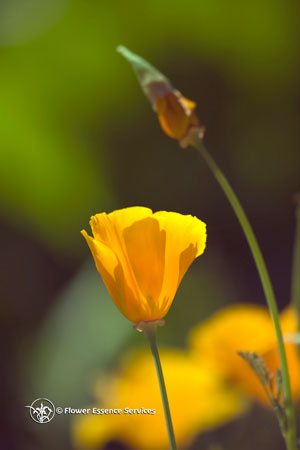 The early Spanish settlers of California saw vast displays of the California Poppy lighting up the coastal hillsides, and it is said they could guide their ships by the sight. They called the California coast the “land of fire,” and the plant the “cup of gold,” (“copa de oro”). It is also known as the Golden Poppy and Cups of Flame. The botanical name
Eschscholzia
(despite the misspelling) honors German surgeon and naturalist Friedrich Gustav von Eschscholtz, who saw the San Francisco Bay area hills emblazoned with California Poppy while on a Russian expedition ship in the early 19th century.
The early Spanish settlers of California saw vast displays of the California Poppy lighting up the coastal hillsides, and it is said they could guide their ships by the sight. They called the California coast the “land of fire,” and the plant the “cup of gold,” (“copa de oro”). It is also known as the Golden Poppy and Cups of Flame. The botanical name
Eschscholzia
(despite the misspelling) honors German surgeon and naturalist Friedrich Gustav von Eschscholtz, who saw the San Francisco Bay area hills emblazoned with California Poppy while on a Russian expedition ship in the early 19th century.
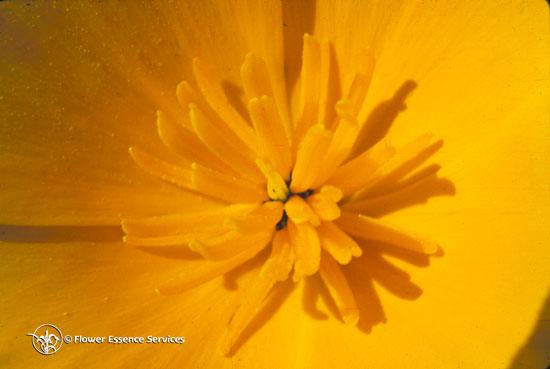
 This deeper insight into the soul gesture of the California Poppy helps us to understand why it has traditionally been used as a herbal nervine to calm states of pain, restless anxiety, nervous movement and insomnia. These calming qualities help one to come to a place of rest, receptivity and inner containment. As a flower essence, these same properties of the California Poppy work not only in the body but also the soul consciousness. The California Poppy is one of the key remedies to deal with patterns of addiction, restless seeking and experimentation, along with ever-fluctuating desires. One who needs this flower essence is challenged to learn how to hold life experiences even when unpleasant: pain, anxiety or uncertainty. Gradually the soul learns ever greater inner responsibility, calm containment and self mastery. It is this chalice of gold within the heart that learns to receive and embrace all of life, so that the very light that we seek becomes that light that we radiate as a blessing to others.
This deeper insight into the soul gesture of the California Poppy helps us to understand why it has traditionally been used as a herbal nervine to calm states of pain, restless anxiety, nervous movement and insomnia. These calming qualities help one to come to a place of rest, receptivity and inner containment. As a flower essence, these same properties of the California Poppy work not only in the body but also the soul consciousness. The California Poppy is one of the key remedies to deal with patterns of addiction, restless seeking and experimentation, along with ever-fluctuating desires. One who needs this flower essence is challenged to learn how to hold life experiences even when unpleasant: pain, anxiety or uncertainty. Gradually the soul learns ever greater inner responsibility, calm containment and self mastery. It is this chalice of gold within the heart that learns to receive and embrace all of life, so that the very light that we seek becomes that light that we radiate as a blessing to others.
